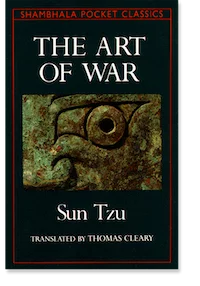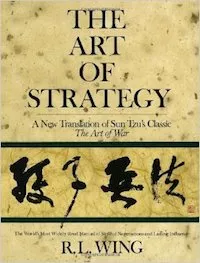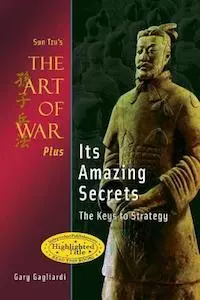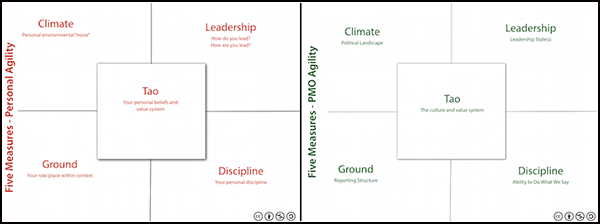The Five Measures Canvas for Agile Transformation
Overview
The Five Measures is a tool from Sun Tzu’s The Art of War. It is the first tool he introduces in the book and it lays the foundation for everything that follows in what is one of the most well known, and widely used sources, that offers guidance on how to cope with situations that involve challenges or will require some form of negotiation. Personally, I began studying and using the tools in The Art of War over 20 years ago. While the premise of the book is rooted in the idea of war, what it has to offer can be (and has been) applied far beyond that area. A search on Amazon will result in thousands of translations, adaptations and detailed examinations of the text that cover everything from raising children, to playing golf, to coping with the challenges many of us face day-to-day in an office setting.
In this post, my goal is to provide an brief explanation of what the Five Measures are, why they are so valuable and how they can be applied in Agile adoption. In working with teams and individuals who are adopting Agile, the Five Measures is something I use in preparation for working with both the Personal Agility Canvas and the PMO Agility Canvas (which will be covered in upcoming posts).
The Five Measures
The Five Measures forms the foundation on which every other concept and tool in the book is based. In any conflict, situational awareness, or context, is often the factor that sets things up for success or failure. So whether you are actually engaging in battle; entering into a negotiation over which projects to pursue and which to drop; or simply having a conversation with management about how to cope with one of the many challenges we face during Agile Transformation, developing a mindful understanding of your surroundings makes all the difference.
The Five Measures are:
- The Tao
- The Climate
- The Ground
- The Leadership
- The Discipline
Because I have found that The Tao can often be tough to understand without context, I will start with explaining the other four elements first.
The Ground
In battle, the terrain on which you will engage your opponent can have a major impact on your strategy. Is the ground rocky or muddy? Will we gain an advantage because we are in a higher elevation than our opponent? How much visibility do we have into the battlefield? The Ground is where we enter into the negotiation and the more we know about it, the better our chances. In an office setting, this can be related to the organizational structure. In every organization there is a defined breakdown of power and responsibility. Person B reports to Person A and because of his/her role and title, there are specific things Person B is expected to be responsible for and certain things the organization expects them to take action on. If you were to collect an org. chart and a RACI matrix from your department or your HR department, this should provide you with the detail you need to understand how the ground on which you will engage shapes the scope of what you should be able to get done.
The Climate
If you were going into battle, understanding the terrain is not enough. You also have to factor what the weather will be like when you engage. Will we be engaging the opponent in a hot environment or a cold one? Will it be raining or dry? Will we engage in the daytime or will it be night? In a work environment, this relates to the political environment. In any company, overlaid on top of the org. chart is the political structure. For example, I may know that if I go directly to Senior Executive A, I am not likely to get the response I desire because of where I sit in the organizational structure. However, because Manager B is a rising star within the company, and seen as the one who is helping to shape the future of the company, I may be able to expect that by winning over Manager B and gaining their support, they will help strengthen my case when I do go to Senior Executive A.
I have worked in a number of office settings where the easiest way to get access to a specific person was through someone else – maybe an Admin that I make friends with so that they will find room for me in the schedule of the person I want to interact with. The Climate is where social engineering tools and techniques become very important. We have to understand who has sway, who does not, and how to leverage that information to our advantage.
In the context of Agile Transformation at a company level, understanding who holds what rank in the organization and who has the juice to be able to help strengthen our efforts towards adoption is a vital aspect of success.
The Leadership
Developing awareness of “how” your organization is led is a crucial factor. For example, what is the style of leadership employed by those in charge or the organization in general? Steve Jobs is a great example of a very charismatic, but (arguably) abusive leader. He had a vision that pulled people in. He pushed them very hard and together they did the impossible. Jobs asked this of them because of their devotion to him and his ideals.
I have had the great fortune to work for some leaders who led through trust. Often, when I asked for direction, I was just told to do whatever made the most sense. For the right kind of people, this can be a dizzying, but powerful motivator. I’ve also worked with leaders who were extremely command and control focused. While it would be easy to characterize some styles as good and some as bad, understanding The Five Measures is not about tagging things with a value judgment. It is simply about understanding. Studying the way your leadership inspires or motivates people to work (and change) adds another vital dimension to the context.
The Discipline
This is a breaking point for many organizations that want to adopt Agile. Whether it is at the Executive level or the Team level, the question to ask is, to what extent do we have the ability to do what we say we will do? The road to Agile is littered with bodies that fell victim to “Executive Read HBR article on Airplane” syndrome, where someone in a position of power read about the promise of Agile and directed portions of the company to “go be Agile” with no desire or ability to actually change how they, and the company, interact with the work.
In the context of war, this is simple… are the troops so disciplined that when things go sideways in battle, they will hold the line and let the training guide them, or, will they go running helter skelter in a state of panic. When our organization agrees to adopt a set of Agile practices like Scrum, do we have the discipline to actually keep our Daily Scrum meetings to 15 minutes? Does the business side have the discipline to not try to change the commitment in mid sprint. Does the Scrum team actually hold all the ceremonies and do they protect the way they work?
The Tao
The Tao can loosely be translated into “The Way”. This is at the center of The Five Measures. What is the culture of the organization? Is it one that is supportive of difficult change? Does the business make it’s decisions by burning tomorrow to save today? What is the value system in place? Tying this back to The Leadership and The Discipline, does the company (or client) culture demonstrate that it truly does support the idea of experimentation and learning from failure? Does leadership demonstrate that it has discipline to let the teams work iteratively to find the best way of delivering the most value despite the fact that learning how to do so is going to include a certain degree of failure along the way? Or, does the culture support change only so far as it does not demonstrate that it will have any negative cost impact? In short, what makes this company tick? It is somewhat more difficult to pin down than the other four measures, but each of them feeds into this one.
Practical Application
When I am working with clients who are pursuing Agile adoption, I use the Five Measures to develop context and situational awareness of what is going on around me and in what environment I am going to be trying to promote change. In many ways it is about developing mindfulness so that as the work of Agile Transformation begins, we can have an open, transparent conversation about what we are facing. In some ways it is like a pre-emptive Retrospect, helping us to observe and understand before we begin trying to promote change.
The Five Measures Canvas offers a visual representation of the tool and can be used individually, or in a group.
If you are interested in The Art of War and would like to learn more, here are the three translations I recommend for getting started:
 The Art of War – Translated by Thomas Cleary (Shambala Pocket Edition)
The Art of War – Translated by Thomas Cleary (Shambala Pocket Edition)
This is a great, lightweight introduction that offers a simple explanation of the ideas presented in the text. This is a great starting point if you are new to Sun Tzu.
 The Art of Strategy – A New Translation of Sun Tzu’s Classic The Art of War by R.L. Wing
The Art of Strategy – A New Translation of Sun Tzu’s Classic The Art of War by R.L. Wing
R.L. Wing begins each chapter of the book with an overview of the subject and then explains it on multiple levels that I have found invaluable in my understanding of how the system works. For each chapter Wing explores: Conflict In The Self, Conflict In The Environment, Conflict With Another, and Conflict Among Leaders.
 Sun Tzu’s The Art of War Plus Its Amazing Secrets by Gary Gagliardi
Sun Tzu’s The Art of War Plus Its Amazing Secrets by Gary Gagliardi
Once you become familiar with ideas in The Art of War, Gagliardi’s breakdown of how to they work and his diagrams explaining the approach provide great insight into how to employ the tools in everyday life.

